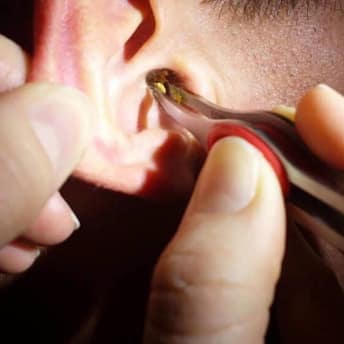Symptoms of earwax build-up 977
by Admin
Posted on 14-09-2022 08:38 AM

Earwax , or cerumen, is a self-cleaning agent your body produces. It collects dirt, bacteria, and other debris. Usually, the wax works its way out of the ears naturally through chewing and other jaw motions. Many people never need to clean their ears. Sometimes, though, wax can build up and affect your hearing. When earwax reaches this level, it’s called impaction.
If you have impaction, you may experience symptoms like:
aching in the affected
ear
fullness or ringing in the ear
impaired hearing in the affected ear
an odor coming from the affected ear
dizziness
a cough
you may be more likely to develop excess wax if you use hearing aids or earplugs.
There are several ways to clean your ears and remove your earwax safely at home. Washing regularly should be enough to keep your ears clean, but you can also use a damp washcloth to gently clean the outside of your ears, or an ear irrigation kit along with wax softeners and preventers to combat buildup and moisturise the ear canal. However, removing your earwax is only advised if your symptoms aren’t urgent and you haven’t noticed any other issues such as pain or a change in your hearing. If you are considering removing earwax at home, avoid inserting any objects into your ear canal, as this can actually push the wax in further and may cause permanent damage.
Ideally, no; your ear canals shouldn’t need cleaning. But if too much earwax builds up and starts to cause symptoms or it keeps your doctor from doing a proper ear exam, you might have something called cerumen impaction. This means earwax has completely filled your ear canal and it can happen in one or both ears. The symptoms of cerumen impaction are: pain or a feeling of fullness in your ear feeling like your ear is plugged partial loss of hearing, which worsens over time ringing in your ear, known as tinnitus itching , discharge, or a smell coming from your ear coughing this kind of earwax buildup is rare, but it can happen.
Never try to remove a build-up of earwax yourself with your fingers, a cotton bud or any other object. This can damage your ear and push the wax further down. If the earwax is only causing minor problems, you can try buying some eardrops from a pharmacy. Using drops may make your hearing or symptoms a little worse at first before getting better. These can help soften the earwax so that it falls out naturally. There are several different types of eardrops you can use, including drops containing sodium bicarbonate, olive oil or almond oil. However, eardrops aren't suitable for everyone and some can irritate the skin.
How you can treat earwax build-up yourself
Speak to a pharmacist about earwax build-up.
 They can give advice and suggest treatments. They might recommend medicines to dissolve the earwax. The earwax should fall out on its own or dissolve after about a week. Do not use drops if you have a hole in your eardrum (a perforated eardrum).
They can give advice and suggest treatments. They might recommend medicines to dissolve the earwax. The earwax should fall out on its own or dissolve after about a week. Do not use drops if you have a hole in your eardrum (a perforated eardrum).
You can get many ear cleaning home remedies over the counter. But most of these treatments — such as irrigation or ear vacuum kits — aren't well studied. This means they may not work and may be dangerous. The safest way to clean your ears if you have excess wax is to see your health care provider. If you're prone to earwax blockage, your health care provider can show you safe ways to reduce wax buildup at home, such as using ear drops or other earwax-softening agents. People shouldn't use ear drops if they have an ear infection unless it's recommended by a health care provider.